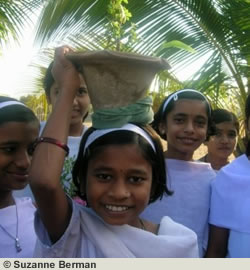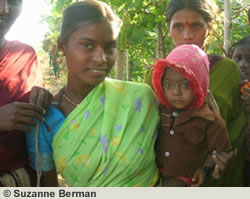Vol 8 Issue 2SectionsPriorities This IssuePrioritiesThoughts on “Food, Family, Friends, and Faith: Celebrating Interview with Dr. Nancy Whitt, Quaker/ Grandmother’s Fruitcake Family>> TransitionsTraditionsChristmas Traditions and Transitions>> Sensory Christmas Traditions>> An Interview with Rabbi Jonathan Miller, Temple Emanu-El>> Wisdom & Wondering
|
TransitionsBackpacking Beyond the Bible Belt: South Africa, India and White
With that, I realized that the stares I had received in my first two days in India would not be stopping anytime soon. For the first time since being in Tanzania five years ago, the color of my skin would overshadow all other aspects of my character. Only days prior to my conversations with Dr. Abhay, I had found myself in an entirely different forum for race relations. In Johannesburg, South Africa the legal walls of Apartheid may have fallen, but the tangible barbed wire fences and “Armed Response” security gates create two distinct worlds for blacks and whites.
While I have spent the last four months being an obvious outsider, and the occasional second glance or air of disapproval no longer surprises me, nothing had prepared me for the blatant stares that awaited me in Latur. I have been told that for the majority of the population, I am the first white person they have seen that was not on television. I am more than a minority; I am a novelty, but often times, I feel like an outcast. It is as if I am the Samaritan woman, walking to and from the well while people pretend to ignore me and refuse to speak to me. Because I do not represent an acceptable, comfortable form, it seems easy to forget that under my fair skin and hair, there is an actual human being. Because of my skin, 500 intrigued faces snap to attention as I step up to the podium at a secondary school and utter words like “human rights” and “gender equality.” Because I traveled half way around the world, village women are honored that I take the time to sit on their cold floors and have tea. And because of my particular combination of race and nationality, these same housewives share stories of my strained Marathi and ability to consume green chilies with their husbands and friends.
© 2007 ecumininet online! Spiritual Systems, Inc. All Rights Reserved. | View
for Printing
|
| All Content Copyright © 2008-2009 ecumininet online!, Spiritual Systems Inc. All Rights Reserved- Site Design & Maintenance By Atomic Pixels | ||

 “Are there any white people in town?”
“Are there any white people in town?” Although I was staying in a suburban home for abandoned babies, I was told that to walk around the block alone, even in daylight, was a risk I should not take. To be white in Johannesburg meant that you drove with your windows rolled up in your locked, non-air conditioned car because even the slightest opening could result in robbery or worse. But as I pass dilapidated shacks filling overcrowded townships, that suffering in a hot car is a much better fate than that which awaits blacks. Never in all my travels have I seen two distinct worlds in one country, and it breaks my heart. In Johannesburg, I learned that despite having one of the most rights affirming constitutions in the world, race creates an undeniable prison for both races.
Although I was staying in a suburban home for abandoned babies, I was told that to walk around the block alone, even in daylight, was a risk I should not take. To be white in Johannesburg meant that you drove with your windows rolled up in your locked, non-air conditioned car because even the slightest opening could result in robbery or worse. But as I pass dilapidated shacks filling overcrowded townships, that suffering in a hot car is a much better fate than that which awaits blacks. Never in all my travels have I seen two distinct worlds in one country, and it breaks my heart. In Johannesburg, I learned that despite having one of the most rights affirming constitutions in the world, race creates an undeniable prison for both races. But while my color made me a target in South Africa, in India it made me feel like a freak. The large, cosmopolitan cities may have a different atmosphere, but in this town of 350,000, the concept of race is a moot point. Despite some religious and class differences, everyone is Indian, and 90% are not only from the state of Maharastra, but more specifically, from the town of Latur. Everyone that is, except me. Here, I look different, I speak strangely, and everyone pronounces my name with a “g” where the “z” should be.
But while my color made me a target in South Africa, in India it made me feel like a freak. The large, cosmopolitan cities may have a different atmosphere, but in this town of 350,000, the concept of race is a moot point. Despite some religious and class differences, everyone is Indian, and 90% are not only from the state of Maharastra, but more specifically, from the town of Latur. Everyone that is, except me. Here, I look different, I speak strangely, and everyone pronounces my name with a “g” where the “z” should be.  However, there does seem to be some benefit to my novelty status. When “the foreigner” smiles, people smile back. When I take the time to learn a few words of Marathi, or bow to an elder, entire families laugh with excitement. Because I look the way I do, over 200 girls sit (literally) at my feet, eagerly asking about what it is like to be a woman in America and how I “got my father” to let me travel alone.
However, there does seem to be some benefit to my novelty status. When “the foreigner” smiles, people smile back. When I take the time to learn a few words of Marathi, or bow to an elder, entire families laugh with excitement. Because I look the way I do, over 200 girls sit (literally) at my feet, eagerly asking about what it is like to be a woman in America and how I “got my father” to let me travel alone. In Latur, race is both an impediment and an asset. When it becomes a burden, I am learning how to defend myself, but when it is otherwise, I am intimidated by its power. I realize that my outward appearance makes me an unintentional ambassador of my culture. And somehow, I must find a way to single-handedly convince Indians that not all American s are the selfish, greedy and immoral people they see on television. I don’t know if I am managing to do so, but I have been practicing non verbal communication—trying to exude the type of unconditional love and kindness that Jesus demonstrates in scripture. Through my openness to experience a different culture, I hope that I showed a willingness to learn and an undeniable humanity that makes “Suganne” more than the color of her skin.
In Latur, race is both an impediment and an asset. When it becomes a burden, I am learning how to defend myself, but when it is otherwise, I am intimidated by its power. I realize that my outward appearance makes me an unintentional ambassador of my culture. And somehow, I must find a way to single-handedly convince Indians that not all American s are the selfish, greedy and immoral people they see on television. I don’t know if I am managing to do so, but I have been practicing non verbal communication—trying to exude the type of unconditional love and kindness that Jesus demonstrates in scripture. Through my openness to experience a different culture, I hope that I showed a willingness to learn and an undeniable humanity that makes “Suganne” more than the color of her skin.